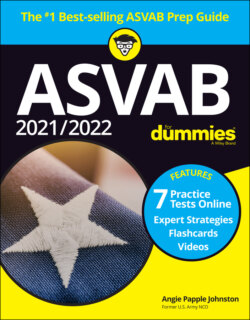Читать книгу 2021 / 2022 ASVAB For Dummies - Angie Papple Johnston - Страница 15
На сайте Литреса книга снята с продажи.
Defining all the scores
ОглавлениеWhen you take a test in high school, you usually receive a score that’s pretty easy to understand — A, B, C, D, or F. (If you do really well, the teacher may even draw a smiley face on the top of the page.) If only your ASVAB scores were as easy to understand.
In the following list, you see how your ASVAB test scores result in several different kinds of scores:
Raw score: This score is the total number of points you receive on each subtest of the ASVAB. Although you don’t see your raw scores on the ASVAB score cards, they’re used to calculate the other scores. You can’t use the practice tests in this book (or any other ASVAB study guide) to calculate your probable ASVAB score. ASVAB scores are calculated by using raw scores, and raw scores aren’t determined by adding the number of right or wrong answers. On the actual ASVAB, harder questions are worth more points than easier questions are.
Standard scores: The various subtests of the ASVAB are reported on the score cards as standard scores. A standard score is calculated by converting your raw score based on a standard distribution of scores with a mean of 50 and a standard deviation of 10.© John Wiley & Sons, Inc.FIGURE 1-2: A sample ASVAB score card used for military enlistment purposes. Don’t confuse a standard score with the graded-on-a-curve score you may have seen on school tests — where the scores range from 1 to 100 with the majority of students scoring between 70 and 100. With standard scores, the majority score is between 30 and 70. That means that a standard score of 50 is an average score and that a score of 60 is an above-average score.
Percentile scores: These scores range from 1 to 99. They express how well you did in comparison with another group called the norm. On the student version’s score card, the norm is fellow students in your same grade (except for the AFQT score).On the enlistment and student score cards, the AFQT score is presented as a percentile with the score normed using the 1997 Profile of American Youth, a national probability sample of 18- to 23-year-olds who took the ASVAB in 1997. For example, if you receive a percentile score of 72, you can say you scored as well as or better than 72 out of 100 of the norm group who took the test. (And by the way, this statistic from 1997 isn’t a typo. The ASVAB is usually “re-normed” every 15 to 20 years; the last time was in 2004, and the sample group used for the norm was those folks who took the test in 1997.)
Composite scores (line scores): Composite scores are individually computed by each service branch. Each branch has its own particular system when compiling various standard scores into individual composite scores. These scores are used by the different branches to determine job qualifications. Find out much more about this topic in Chapter 2.
